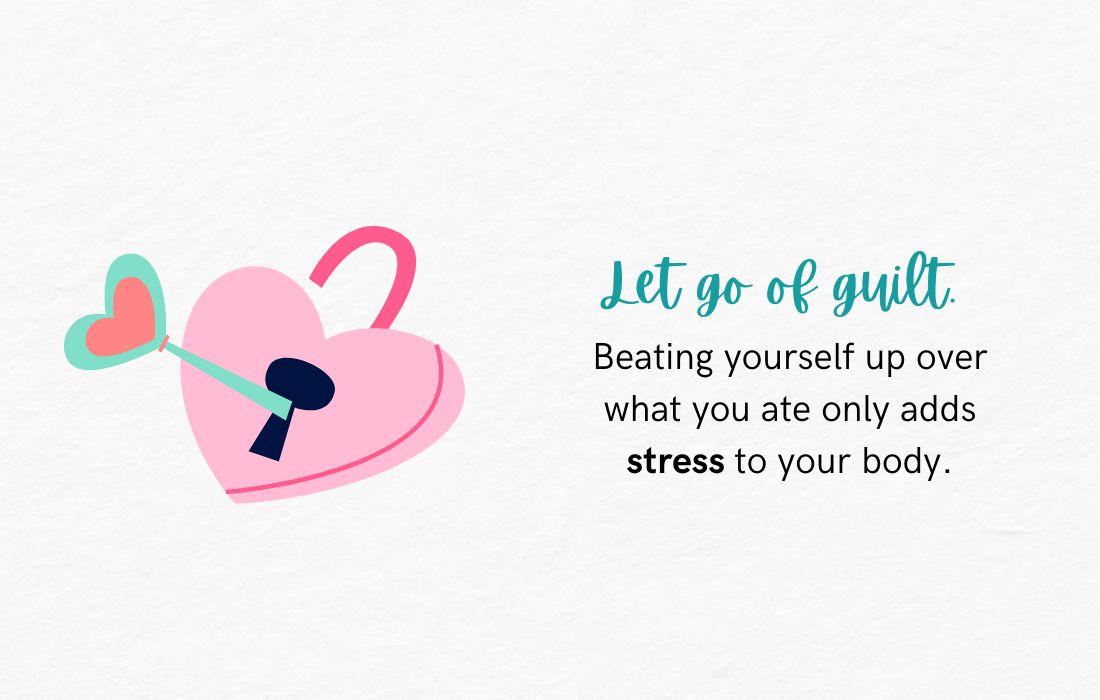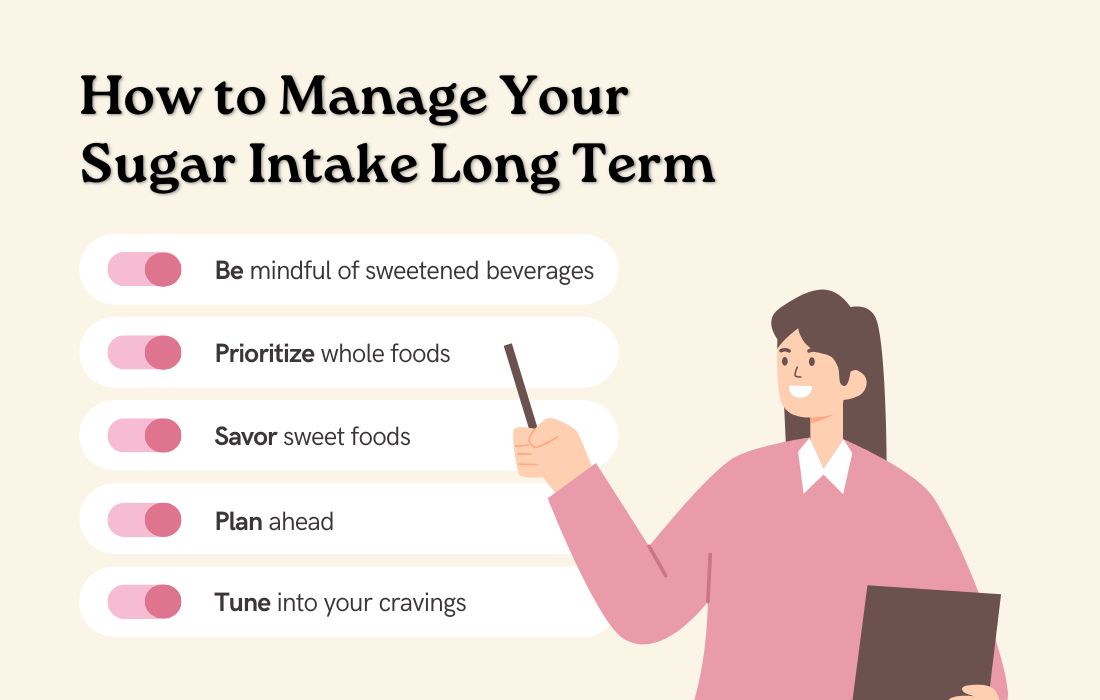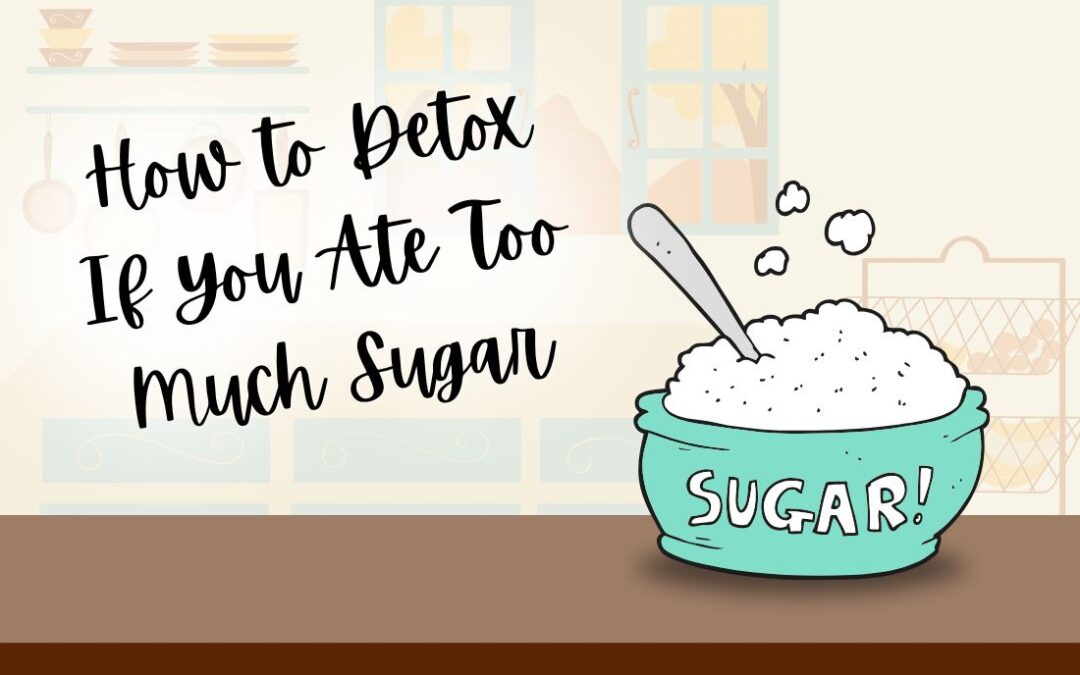“I ate too much sugar…how to detox?”
We’ve all been there—you go on a sugar binge and now you’re feeling the effects. Whether it’s bloating, fatigue, or just feeling off, you’re probably looking for a way to get back on track and feel like yourself again.
The good news is that there are simple steps you can take to restore balance in your body, reduce cravings, and stop that any lingering guilt in its tracks!
Let’s dive into how to detox and reset after a sugar binge.
Written by Jenn Hand, Holistic Nutritionist, Board Certified Health Coach, NBC-HWC
Table of Contents
- How to Detox If You Ate Too Much Sugar
- The Science Behind a Sugar Detox
- How to Manage Your Sugar Intake Long Term
- How Sugar Affects Your Body in the Short and Long Term
- Healthy Alternatives to Refined Sugar
- How Much Sugar Is Too Much?
- What Are the Signs of Sugar Overload?
- Tackle Cravings So You Don’t End Up Bingeing
- Focus on Desserts that Contain Whole Foods
- Forget the Guilt and Focus on Progress
- Common Questions
How to Detox If You Ate Too Much Sugar
Sugar overload happens to the best of us—whether it’s a celebration, a holiday, or simply a night of “too much” of your favorite candy.
If you’re feeling the effects of eating too much sugar, don’t stress! Here’s a step-by-step guide to help you reset and feel good again without any drastic measures.
1. Go Easy On Yourself
First things first: let go of any guilt.
Beating yourself up over what you ate only adds stress to your body. Remind yourself that one day (or even a few days) of extra sugar isn’t a reflection of your worth, nor does it undo all your efforts toward balance. Remind yourself it’s okay and you’re human.
2. Move Your Body
Gentle movement can work wonders after a sugar overload.
Whether it’s yoga, stretching, or a brisk walk, moving your body helps improve digestion and stabilize your blood sugar. Don’t overdo it—this isn’t about punishment but about feeling better.
3. Drink Lots of Water
Hydration is key! Sugar can dehydrate your body, leaving you feeling sluggish.
Sip on water throughout the day to flush out excess sugar and support your kidneys. Add a slice of lemon or cucumber for an extra detoxifying boost. Staying hydrated is important so don’t overlook this tip just because it seems simple.
4. Eat a Protein-Packed Snack
Protein helps stabilize blood sugar and reduces the rollercoaster effect of sugar spikes and crashes.
Reach for a handful of almonds, a boiled egg, or Greek yogurt with some nuts. This will keep your cravings stable and keep you full longer.
5. Be Mindful of Your Sugar for the Rest of the Day
To give your body a break, see if you can be mindful of your sugar intake for the rest of the day.
Focus on whole, minimally processed foods like veggies, lean proteins, and healthy fats. This will help your body naturally rebalance itself without overloading it further.

6. Add More Fiber to Your Diet
Fiber-rich foods like vegetables, whole grains, and legumes can help slow digestion and stabilize blood sugar levels.
Aim for a salad with leafy greens, roasted veggies, or a bowl of hearty lentil soup to feel nourished and satisfied.
7. Replenish Electrolytes
Lots of sugar can deplete your body of essential minerals like magnesium and potassium.
Hydrate with water and incorporate electrolyte-rich options like coconut water or a banana to replenish what your body needs.
8. Take a Walk or Light Exercise
If you feel sluggish after a sugar binge, a short walk or some light activity can help improve your mood and energy levels.
Bonus: it also supports your digestion and helps you feel more balanced.
9. Plan Your Next Meal Mindfully
If sugar cravings hit again, plan your next meal intentionally to balance your blood sugar.
Include protein, fiber, and healthy fats to keep you satisfied and minimize the temptation for more sugar. Mindful choices now pave the way for a better tomorrow.
Remember, detoxing from sugar is less about strict rules and more about small, intentional actions to support your body and feel your best.

The Science Behind a Sugar Detox
Is there really any science to “detoxing” from sugar?
While the body naturally eliminates excess sugar through the liver and kidneys, the effects of a sugar overload—like fatigue, headaches, and mood swings—are very real. These symptoms are tied to how sugar affects blood glucose levels, spiking them and causing subsequent crashes.
Stabilizing your blood sugar through hydration, protein, and fiber helps reduce these effects, supporting your body’s natural processes.
A sugar detox isn’t about “cleansing” your body but about giving it a break from excess added sugar intake. By balancing your meals and making mindful choices, you allow your body to recover and feel more balanced.
How to Manage Your Sugar Intake Long Term
Managing sugar intake over the long term doesn’t mean cutting out all sweet foods.
Instead, it’s about building habits that help you enjoy sugar in moderation while reducing added sugar intake from sources that don’t serve your health.
- Be mindful of sweetened beverages: Drinks like soda, fruit juice, and energy drinks are some of the biggest contributors to added sugar intake. Opt for water, herbal teas, or sparkling water with a splash of lemon or lime instead.
- Prioritize whole foods: Filling your plate with vegetables, whole grains, lean proteins, and healthy fats helps minimize sugar cravings by keeping you full and satisfied.
- Savor sweet foods: Rather than eliminating sweet foods, focus on enjoying them intentionally. For example, a small square of dark chocolate or a homemade treat can satisfy your sweet tooth without overdoing it.
- Plan ahead: Prepare balanced meals and snacks to avoid last-minute reliance on sugary, processed foods.
- Tune into your cravings: Sugar cravings can be tied into emotional triggers or hunger. Practice self-awareness to understand whether you’re truly hungry or seeking comfort, and address those needs without automatically turning to sweet foods.
Over time, these strategies can help you find a balanced relationship with sugar—one where you can enjoy it without it controlling you.

How Sugar Affects Your Body in the Short and Long Term
Excess sugar consumption has immediate effects like energy crashes, mood swings, and bloating.
In the long term, consistently high sugar intake can lead to weight gain, insulin resistance, and a higher risk of conditions like diabetes.
You probably don’t want to ban sugar altogether as that could backfire. But there’s nothing wrong with eating a tasty high-quality dessert a few times per week.
My strategy to enjoy sweets without going crazy and eating an entire bag of Reeces Peanut Butter Cups involves being intentional, planning ahead and being in the experience of eating the treat.
I do enjoy quality dessert, and I’ve learned that the key to enjoying it without going overboard is to eat it intentionally.
For example, if I’m craving something sweet, I’ll go for something I truly love, like a small slice of a homemade brownie or a few squares of rich dark chocolate. I’ll sit down, savor it slowly, and enjoy every bite.
I also pair sweets with something that helps me feel more balanced. If I’m having dessert, I might have it after a meal with protein and veggies to keep my blood sugar steady.
And when I’m tempted to grab a whole bag of Reese’s Peanut Butter Cups (trust me, I’ve been there!), I’ll remind myself that I can always have more tomorrow if I really want it. That permission takes away the urgency to eat it all in one sitting.
For me, it’s not about being perfect—it’s about finding what works to enjoy the sweetness of life without letting it take over.
Listen to a Related Podcast:
Healthy Alternatives to Refined Sugar
If your sweet tooth is calling, there are plenty of delicious, nutrient-dense foods and natural sweeteners that can satisfy your cravings without the energy crashes or sugar spikes of highly sweetened foods.
- Fruit-based desserts: Whole fruits like bananas, dates, or berries are naturally sweet and packed with fiber, vitamins, and minerals. Blend frozen bananas into a creamy “nice cream” or bake apples with a sprinkle of cinnamon for a warm treat. I also use coconut sugar in baking (which doesn’t impact your blood sugar like white sugar does.)
- Natural sweeteners: Options like honey, maple syrup, and coconut sugar are less processed and often bring extra flavor. While they still contain sugar, they tend to be more nutrient dense than refined sugar.
- Dark chocolate: Swap milk chocolate for a piece of dark chocolate (70% cocoa or higher). It’s rich and satisfying with less sugar.
- Homemade treats: Making your own sweetened foods lets you control the sugar content and use more wholesome ingredients. Energy balls made with dates, oats, and nut butter are a great example.
For more ideas and recipes, check out my blog post called Can You Eat Dessert Every Day and Still Lose Weight? It’s packed with inspiration for treating yourself while staying balanced.

How Much Sugar Is Too Much?
There’s no one-size-fits-all answer, but keeping your added sugar intake balanced is key to feeling your best.
Instead of focusing on strict numbers, aim to be mindful of added sugars from processed and sweetened foods while enjoying naturally sweet options like fruit. Finding a balance that works for your body helps you maintain energy and health without feeling deprived.
What Are the Signs of Sugar Overload?
Overeating sugar can leave you feeling tired, bloated, and moody.
You might notice energy crashes, increased sugar cravings, headaches, or difficulty concentrating. Physically, sugar overload can also lead to digestive issues like bloating or irregular bowel movements.
If you regularly experience these symptoms after indulging in sweet foods, it might be your body’s way of asking for more balance in your sugar intake.
Tackle Cravings So You Don’t End Up Bingeing
Cravings can feel overwhelming, but you don’t have to let them take over.
Start by making sure you’re eating enough nutrient-dense foods throughout the day, as hunger often fuels sugar cravings. If the urge strikes, pause and ask yourself: What do I really need right now? Sometimes it’s not sugar but rest, connection, or stress relief.
If you do want something sweet, give yourself permission to enjoy it intentionally. Choose a portion that satisfies you, eat it slowly, and savor every bite. This helps you avoid the all-or-nothing mindset that often leads to bingeing.

Focus on Desserts that Contain Whole Foods
Desserts made with whole foods like nuts, fruits, and oats can be just as satisfying as those packed with refined sugar.
These treats provide sweetness alongside fiber, healthy fats, and nutrients that nourish your body. Think banana oat cookies, date-sweetened brownies, or avocado chocolate mousse
Forget the Guilt and Focus on Progress
Remember, this is about progress, not perfection.
One sugary day won’t undo all your efforts, and guilt only adds unnecessary stress. Celebrate the small steps you’re taking to find balance, whether it’s drinking more water, swapping sweetened foods for nutrient-dense options, or savoring dessert without overdoing it.
Progress is about learning what works for you and building habits that help you feel your best—no guilt required.

Common Questions
How can I flush sugar out of my system fast?
While there’s no instant fix, drinking plenty of water and eating fiber-rich foods can help your body process excess sugar more efficiently.
What should I eat to detox from sugar fast?
Focus on whole foods like vegetables, lean proteins, and healthy fats, which support blood sugar balance and reduce sugar cravings.
How long does it take to detox from too much sugar?
For most people, it takes about 3–5 days to feel a reduction in cravings, though it may vary depending on individual habits and metabolism.
How do I burn off the sugar that I just ate?
Light physical activity, like a walk, can help your body use up some of the extra sugar, though it’s more important to focus on balanced meals moving forward.
Is there a quick way to reduce sugar cravings after a binge?
Yes! Eating protein and fiber with your next meals can help stabilize blood sugar and reduce further cravings.
Do I have a sugar addiction?
While sugar can be highly appealing, not everyone is addicted—consider whether cravings feel out of control or stem from restriction.
Are sugary foods a main cause of binge eating?
Sugary foods alone don’t cause binge eating; it’s often the result of restriction, emotional triggers, or unmet needs that drive the urge to overeat.
Will quitting sugar cold turkey help me to stop binge eating?
Quitting sugar completely can sometimes backfire by increasing cravings; a balanced approach that includes occasional sweets may feel more sustainable.
Related Articles
⚪ How to Stop Bingeing On Sugar
⚪ What To Do After Binge Eating Sugar
⚪ Why Do I Binge On Sugar?
Get the Normal Eater’s Newsletter
Join 8000+ women who are overcoming overeating, binge eating, and breaking up with dieting forever. Get Jenn’s inspiring and actionable weekly newsletter with the latest posts, podcasts, and tips on how to love your body, find food freedom, and lose weight holistically.
Get the Normal Eater’s NewsletterWork with an Emotional Eating & Holistic Nutrition Coach
Overcome Bingeing and Emotional Eating and Break Up with Yo-yo Dieting
Working with an emotional eating coach and holistic nutritionist can help you get free from the frustrating binge and restrict cycle and stop yo-yo dieting.
You don’t have to be obsessed with food or have a million rules around eating to find your natural weight and learn to love your body. Ready to actually see a lasting change and experience true freedom?
Schedule a 20-min CallAbout the Author:

Jenn Hand has been helping women like you become normal eaters since 2015.
She’s worked with thousands of women, helping them to balance their bodies, end bingeing, stop obsessing over food, and start feeling amazing again. As a board-certified health coach and holistic nutritionist, Jenn knows how to support you in making real positive changes that last.
Her articles have been published on Mind Body Green, Tiny Buddha, Thrive Global and other local and global media platforms. She’s the author of How to Be a Normal Eater and the creator of The Normal Eater’s Club program. Listen to Jenn’s advice and tips on the Cake Doesn’t Count Podcast, or read more of her articles for free on the Food Freedom Blog.
Learn About Coaching!




